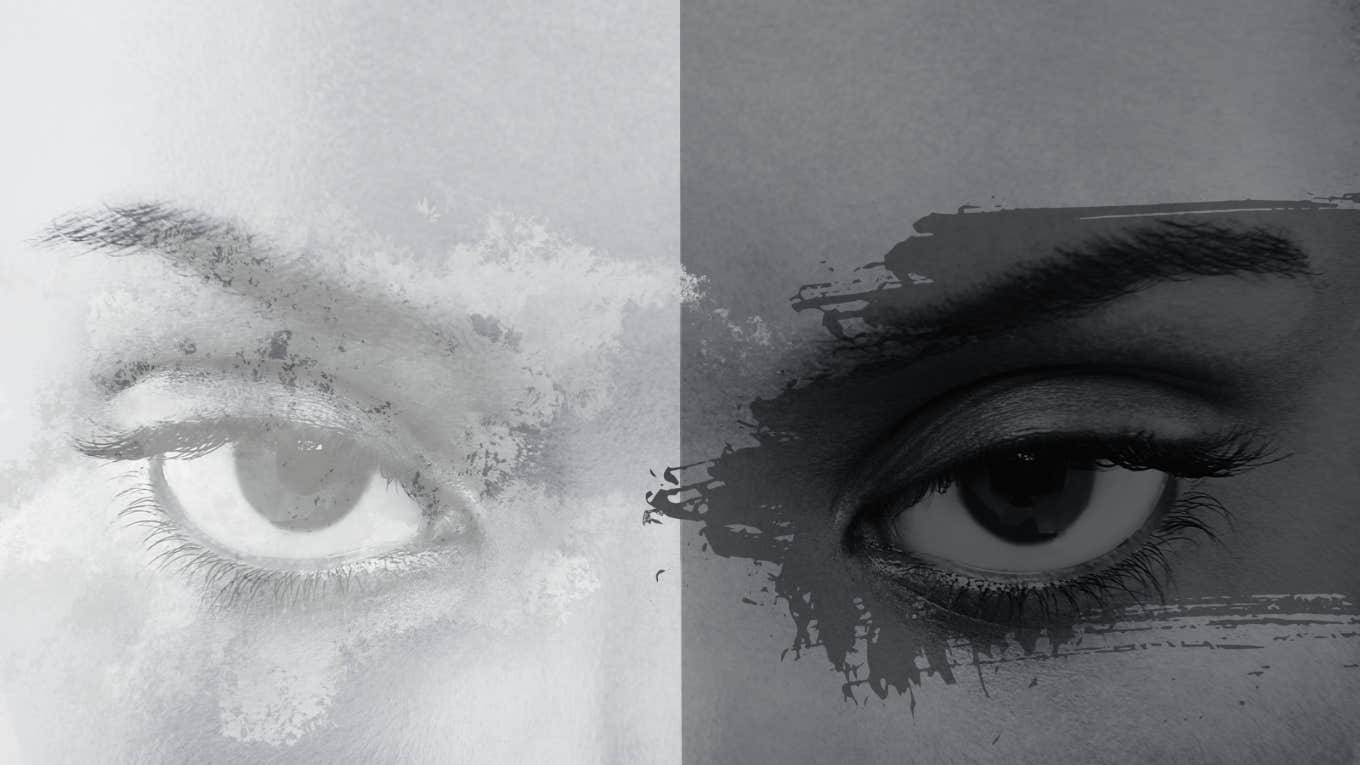Why People With ADHD Are So Prone To Black-And-White Thinking
Good or bad, wrong or right. Having no in-between sets challenges for social situations. Here are eight ways to shift it.
 DAPA Images | Canva
DAPA Images | Canva “It was a total failure,” a client tells me about a situation. Now, listening to their story, what you wouldn’t get from this one statement is the situation is complex. It was full of many small wins, different perspectives, and not absolute. Like most events in our lives, it was nuanced and not the “total failure” my client felt it was.
So why was this situation so clear and simple to my client and not to me? The answer lies in “all or nothing” or “black and white thinking”. This kind of one-way street is common for people with ADHD and other neurodivergent brains, and you may have seen it in your thinking or your loved ones’ thinking before.
If this is you (or your child), please know that it's nothing to be ashamed of. Once you understand this tendency, you can find a way to work with it.
Black-and-white thinking is not the same as stubbornness
Black and white thinkers often characterize things as good or bad, wrong or right, or express their point of view in absolutes like, “there is only one way to do/handle or act” in a situation. There is little gray or middle ground, and the fact most of life happens outside of the extremes is often lost on people with rigid thinking patterns.
If you are living with a black-and-white thinker, you might experience your child as “inflexible” or see your partner as stubborn or “set in their ways”. These characteristics are signs of an all-or-nothing mindset, and they present a specific set of challenges when trying to help your child or partner navigate social situations, make friends, or find peace in a new situation.

Photo Alla Din via Shutterstock
Why so many people with ADHD are black-or-white thinkers
Thinking patterns like these can arise from various environments and neurology, or they can result from life experiences, often due to the experiences and not an intended consequence. In this example, think about someone who experiences a significant loss and makes the decision every relationship ends or everyone leaves.
The truth is we all have a different stress response. Some people find positive ways to cope and are hopeful for the future. Others, unfortunately, getting trapped in anxiety or other negative responses makes navigating life more challenging.
Additionally, sensory issues, ADHD, autism, anxiety, and depression may lead some people to develop a higher intolerance for uncertainty, which can lead to more rigid black-and-white thinking. Research shows dichotomous (AKA black-and-white thinking) is a reaction to the need for control. When chaos and overstimulation rule the brain, it can cause people to seek out areas of their lives they feel in control of, inspiring them to enact even more stringent rules over their lives.
Thinking in absolutes (black/white, correct/wrong, etc) help a brain that is overstimulated or stressed by options make sense of the world. The challenge is that this kind of thinking is a “cognitive distortion” or a view that reflects a misinterpretation of an event. When this kind of thinking goes on without checking or affirming the truth, it can cause inaccurate beliefs to develop a distorted view of the events.
What black-and-white thinking looks like.
A black-and-white thinker may express any of the following.
• The day was “good” or “bad”
• Using words like “always” and “never”
• It was the “best day,” or the “worst day” ever
• I’m “off,” or I’m “on”
• “Nothing went right,” or “It all went perfectly"
• Their opinion is right, and your opinion is wrong.
How black-and-white thinking affects friendships.
Let’s start at the beginning. How you think affects what you do, and your mindset affects how you approach every relationship.
Black-and-white thinking can cause problems in relationships and friendships in 4 critical ways.
- All-or-nothing thinking oversimplifies complex issues, which may mean not seeing all the nuances, weighing your options, and realizing the vital aspects of a situation.
- It often leads to cutting people off, breaking up with them, or dismissing them because black and white thinkers tend to categorize people into categories such as “in or out”.
- Black-and-white thinking amplifies emotions, leading to being too quick to judge, feel affronted, or terminate a relationship.
- Speaking in absolutes can also create conflict with other people and invite defensiveness as other people feel attacked. For example, when someone says, “You never help me,” or I can “never count on you,” friends may feel defensive since this is not an accurate depiction of the situation.
Someone with black-and-white thinking might ask friends, colleagues, or family to choose their perspective rather than being open to others. They may be unable to accept change because of extreme thinking. Or when considering a situation, they may twist events into their thinking pattern to cause them to fall into catastrophizing and negative thought patterns. Any way you look at it, black-and-white thinking is hard to manage either as a person with this kind of thinking pattern or from the perspective of loving someone with this kind of thinking.
Here are 8 strategies to shift black-and-white thinking.
1. Notice your speech and challenge your inner voice.
Recognizing when your thinking moves into all-or-nothing or other extremes is the first step to shifting this pattern. Pay attention to the words you say to yourself and what words signal this a black-and-white thinking pattern.
2. Listen for absolute words.
Always, never, all, none, etc. Look for patterns in your speech that signal this thinking is ongoing. It’s common for catastrophic thinking to follow these word patterns, and you can see the negative picture emerge once you start saying these kinds of words to yourself.
3. Challenge yourself to examine what feels like a fact for holes in your thinking.
For example, if you say to yourself, “I am a total loser today; I didn’t make any of my goals,” ask the question before accepting the statement as a fact. And that next question is: what evidence or facts prove your comment to be true? Try to be open to the “truth” versus trying to prove your case. Open-mindedness is crucial to shifting your fixed mindset into a learning or fluid mindset, which is a key to releasing the hold black-and-white thinking has on your life.

Photo: Dmitry Molchanov via Shutterstock
4. Broaden your perspectives.
This helps reduce the hold that binary thinking has on you. The world is not all black and white; there are many shades of gray, and when you examine your facts, a simple shift to add in the phrase “yes, and…” can open your mind to other truths that coexist with your negative thoughts. For example, “Yes, today did not go as planned, and I tried to make real progress toward my goals.” Remember that your rules are not absolute. They are guidelines.
5. Build your skills.
Being a flexible thinker isn’t an ingrained knowing. It’s a skill kids are taught and practice over time. Before judging yourself for not “getting this right,” check in to see what’s causing the black-and-white thinker to compensate by trying to create control. These skills might include reading between the lines, perspective-taking, or decoding words and what things mean.
6. Increased your emotional tolerance for negative feelings.
Uncertainty can also cause fear, sadness, regret, or anger. When you practice allowing all of your feelings (good or bad) to rise and be without reacting impulsively to squash, avoid, or remove the emotions, you learn that these feelings don’t bring about doom or disaster.
7. Practice self-soothing to cope with uncertainty.
What do you need to feel better when you’re uncomfortable, out of your element, or dealing with new emotions? This can range from taking a pause or a timeout, deep breathing, writing your feelings down, or talking with a trusted friend/confidante.
8. Practice flexibility in your thinking.
When you're stuck in black-and-white thinking, it’s easy to feel trapped into thinking it’s pointless to try something new. This is the moment to stretch yourself and see what you can do with your mindset. Adding greater flexibility to your life does not mean masking or people-pleasing. It’s more about expanding your ability to cope with emotions and uncertainty so you can adapt with less stress to the nuances and gray areas of life.
Black-and-white thinking is super common for people with ADHD and other neurodivergent thinkers. It’s also an area of your life that, with practice, can feel more in your control. This practice is not a perfect one. But learning to see new perspectives, developing a less stringent way of seeing the world, and being gentle with yourself are required.
Whether you have this kind of thinking or love someone with this mindset, it’s possible to adapt your thinking to help the world feel less stressed and at ease to be yourself.
Caroline Maguire, ACCG, PCC, M.Ed. is a personal coach who works with children with ADHD and the families who support them.

